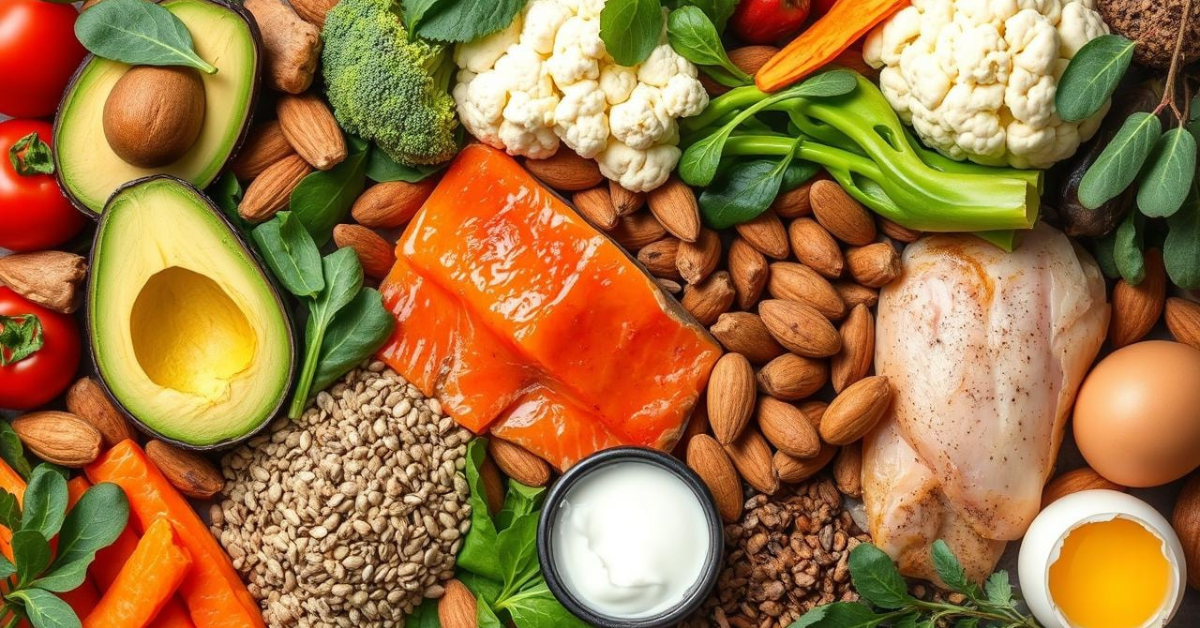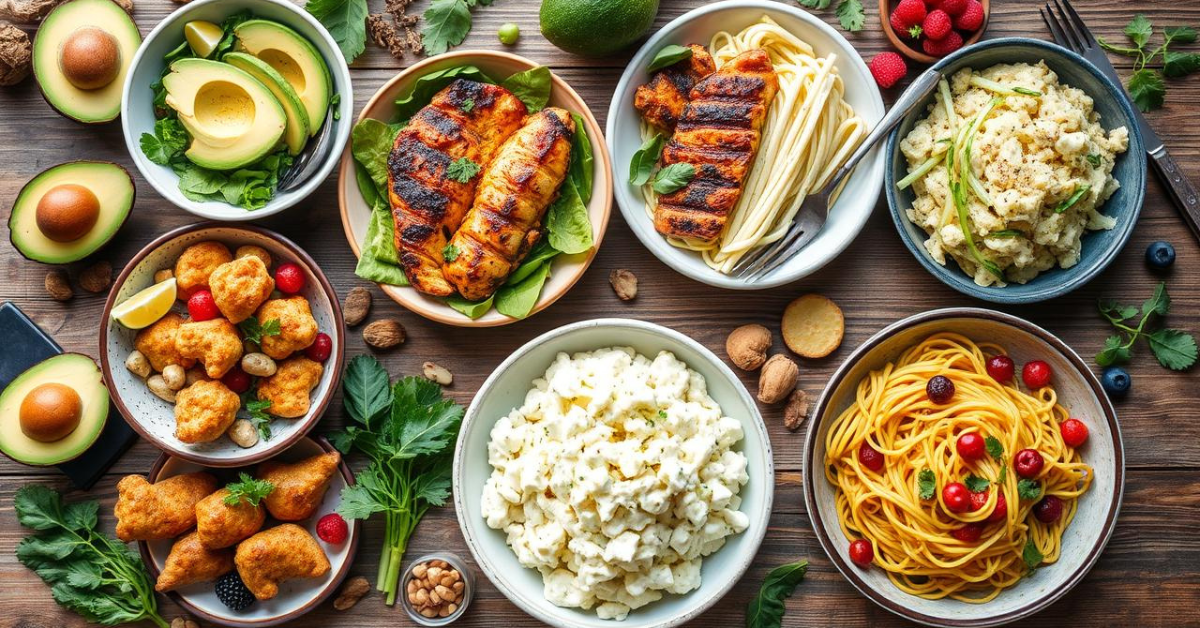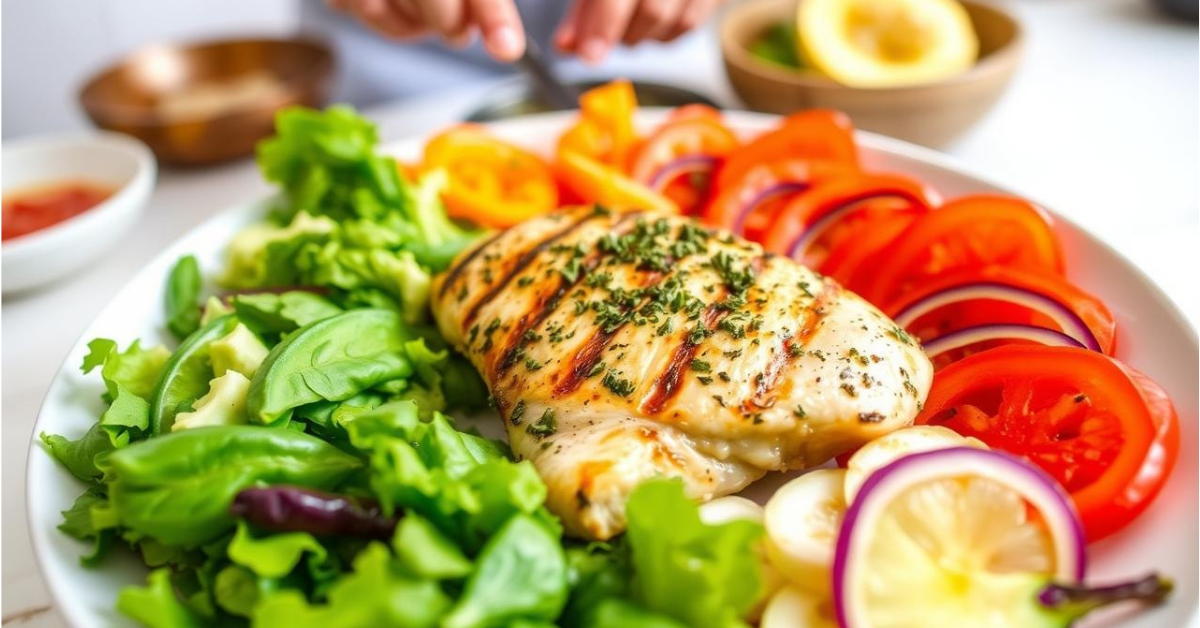Starting a ketogenic diet is like entering a new world. You’ll be excited to switch from eating lots of carbs to a diet full of healthy fats. This Keto Diet Guide is more than just tips; it’s a support system for those ready for a big change. It’s about choosing to put your health first and making a promise to yourself for a better life.
Today, nearly 46% of American adults eat poorly, according to the American Heart Association. Losing weight and staying healthy is tough. This guide is about making better choices and finding more energy and focus. The keto diet puts your body into a state called ketosis, where it uses fats for energy instead of carbs.
Imagine better blood sugar control, more weight loss, and clearer thinking just by changing what you eat. It’s easier than it seems. Studies show that low-carb diets work better for losing weight than low-fat diets. With the right info, you can be the next success story on the keto diet.
Key Takeaways
- Ketogenic diet plan involves drastically reducing carbohydrates to 20-30 grams net carbs per day.
- Entering ketosis helps your body burn fat for fuel, leading to more efficient energy use and weight loss.
- Nutrient intake on keto usually comprises 70% fats, 25% protein, and 5% carbohydrates.
- Tracking your macronutrients using apps like MyFitnessPal can facilitate a smooth transition into the ketogenic lifestyle.
- Health benefits of keto include improved blood sugar control and enhanced mental clarity.
- Support from friends and coworkers has been shown to significantly improve the likelihood of weight loss success.
Understanding the Keto Diet

The keto diet focuses on *ketosis*, a state where the body uses fat for energy by eating very few carbs and lots of fat. To understand what is ketosis, you need to know it’s about eating very low carbs, 5-10% of your total intake. The rest comes from fats and proteins.
There are different keto diets, but the Standard Ketogenic Diet (SKD) is the most popular. It has 70% fat, 20% protein, and just 10% carbs. Then there’s the High-Protein Ketogenic Diet (HPKD), with 60% fat, 35% protein, and 5% carbs. Some diets change carb levels at different times or after workouts.
Studies show the keto diet has many health benefits. For example, older adults on it lost a lot of fat in eight weeks, more than those on a low-fat diet. People with type 2 diabetes lost 26.2 pounds on a keto diet and 60% got their diabetes under control in a year.
The keto diet can also make you healthier in many ways. It can make insulin work better and lower the risk of heart disease. It might help people with certain diseases like polycystic ovary syndrome and Alzheimer’s. A study found it cut seizures in kids by up to 90%.
To stay on the keto diet, avoid high-carb foods and drink plenty of water. Eating snacks like Brazil nuts, cheese, and meat jerky can help. But, starting the keto diet might make you feel sick, with symptoms like stomach pain and muscle soreness.
Benefits of the Keto Diet
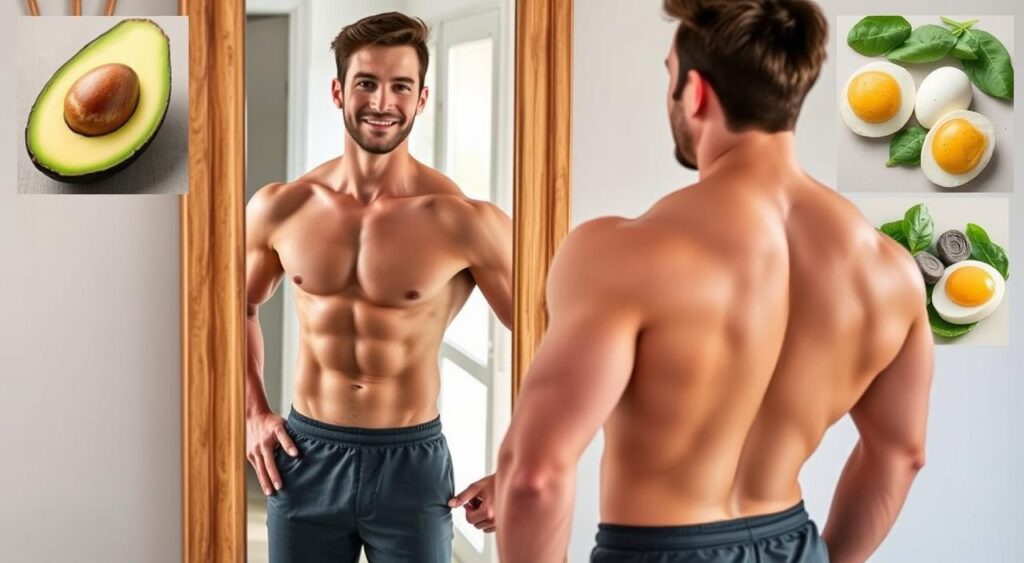
Starting the ketogenic diet offers many health benefits, not just weight loss. Studies show it leads to more weight loss than low-fat diets. For example, a 2013 study found people on keto lost 2 pounds more than those on low-fat diets over a year.
The keto diet greatly improves metabolism. A review of 11 studies showed people on keto lost 5 pounds more than those on low-fat diets in 6 months.
The keto diet also helps improve lipid profiles. A 2017 review found it lowered total cholesterol, LDL, and triglycerides, while raising HDL or “good” cholesterol. This can lower the risk of heart disease.
Keto also has benefits for the brain. Ketones in ketosis may protect against Alzheimer’s and Parkinson’s diseases. The Epilepsy Foundation says ketosis can reduce seizures in people with epilepsy, especially in children.
Women with polycystic ovary syndrome (PCOS) may also benefit from the keto diet. A 2005 study showed it helped with weight loss, hormone balance, and insulin levels in five women. This highlights the diet’s benefits for managing PCOS and other metabolic issues.
However, the keto diet has risks and side effects. Long-term use can cause kidney stones, nutrient deficiencies, and fatty liver. Newcomers may experience the “keto flu,” including fatigue, headaches, and nausea. It’s wise to talk to a doctor before starting, especially if you have health issues like diabetes or heart disease.
Despite the risks, the keto diet’s benefits make it a good choice for many. It aids in weight loss and improves metabolism, enhancing overall health and well-being.
How to Get Started with Keto
Starting a ketogenic diet requires a few key steps. These steps help you begin your keto journey successfully. By setting clear goals, figuring out your macronutrient needs, and tracking what you eat, you can smoothly move into ketosis.
Setting Your Goals
First, define why you want to start with keto. Are you looking to lose weight, improve your health, or boost your mental focus? Having clear goals will guide you and keep you driven. Studies show the keto diet can help with many health issues, like heart disease and type 2 diabetes.
So, making a plan that fits your needs is crucial. This will help you stay on track.
Finding Your Macronutrient Breakdown
The keto diet needs a certain mix of macronutrients to work. You should get about 70-75% of your calories from fats, 15-20% from proteins, and only 5-10% from carbs. For a 2,000-calorie diet, aim for 20-50 grams of carbs a day.
Use a keto diet food list to pick the right foods. Focus on healthy fats like avocados, meats, and oils. Add low-carb veggies for vitamins and minerals.
Importance of Tracking Your Intake
It’s key to keep track of what you eat and drink. Apps or food diaries help you record everything. This ensures you meet your macronutrient goals and avoid hidden carbs.
It also helps with staying hydrated and getting enough electrolytes, which can prevent the “keto flu.” Tracking your food makes meal prep easier, keeping your meals in line with your goals.
These first steps give you a clear path when starting with keto. They make the transition smoother and help you reach your goals.
Entering and Maintaining Ketosis
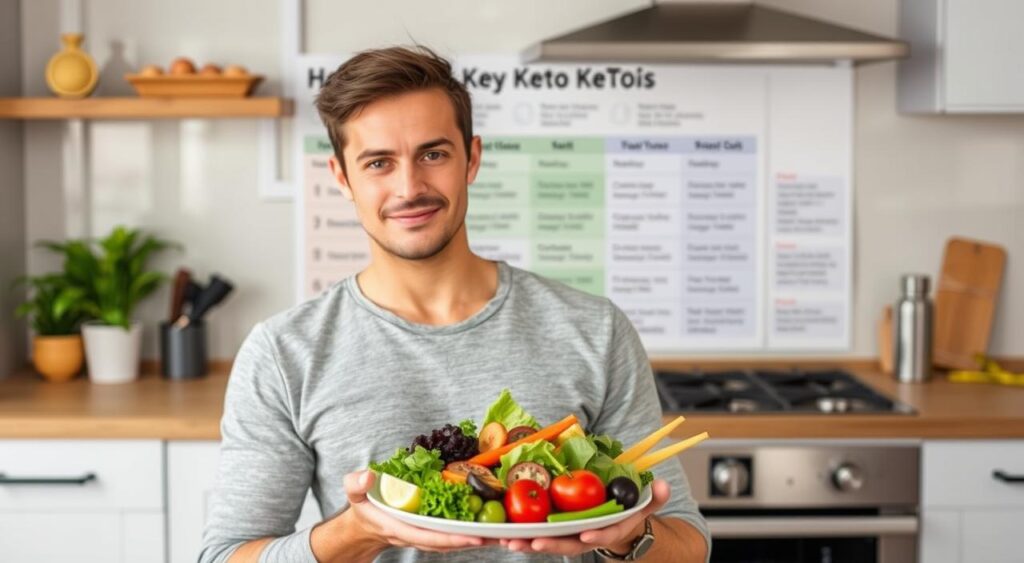
Getting into and staying in ketosis is key to the ketogenic diet. It’s important to know how to achieve ketosis by adjusting what you eat and your lifestyle.
To start ketosis, you need to cut down on carbs a lot. Aim for 50 grams or less a day. For some, it might be as low as 20 grams. This means getting only 5-10% of your daily calories from carbs. This change makes your body use ketones instead of glucose for energy.
- Moderate Protein Consumption: To stay in ketosis, watch how much protein you eat. Aim for 0.55–0.77 grams of protein per pound of lean body mass.
- High-Fat Intake: Eat very few carbs, getting 55–60% of your calories from fats. Foods like coconut oil are great because they have lots of MCTs, helping make more ketones.
- Intermittent Fasting: Short fasts can help you get into ketosis faster by using up glycogen. This makes your liver start making ketones.
- Physical Activity: Being active helps use up glycogen and makes your body use ketones for energy. This helps you achieve ketosis.
Staying in a ketogenic state means paying attention to what you eat and how you live. Use tools like breath, urine, or blood tests to check ketone levels. These can help you adjust your diet to stay on track. Paying attention to signs like feeling thirsty or needing to pee more often also shows you’re in ketosis.
“The breakdown of macros for most people on a ketogenic diet is typically 70% of daily calories from fat, 25% from protein sources, and 5% from carbohydrates, aiming for weight loss, enhanced energy, and athletic performance.”
The keto diet is good for both athletes and regular people. It helps you achieve ketosis for different health goals.
Keto-Friendly Foods to Eat

Choosing the right foods is key to a successful ketogenic diet. Focus on high-quality proteins, healthy fats, and low-carb veggies for balanced nutrition. Here, we explore the best foods for a keto diet and why they’re great for this lifestyle.
Proteins
Proteins are vital for a keto diet, keeping muscles strong and supporting health. Go for grass-fed meat, wild-caught fish, and free-range eggs. Salmon and mackerel are great for omega-3 fatty acids. Choose non-processed meats over bacon and sausage, which have many preservatives.
For plant-based diets, tempeh and natto are top picks.
Two large eggs have no carbs and over 12 grams of protein, making them a keto must-have.
Fats
Healthy fats are crucial in keto recipes. Avocados, nuts, seeds, and oils like coconut and olive oil are great sources. A medium avocado gives about 6 grams of carbs, with 4.5 grams of fiber. Greek yogurt has 8 grams of carbs and 20 grams of protein in a 7-ounce serving, fitting the keto diet.
For more fat, try MCT oil, butter, and ghee. These not only give energy but also keep you full. But, avoid trans fats and heavily processed oils.
Low-Carb Vegetables
Nonstarchy veggies are a must in the keto diet. Broccoli and spinach have less than 8 grams of net carbs per cup, making them ideal. Leafy greens and other veggies are also good for their low carbs and nutrients. They help keep fiber levels up and support health.
Check out a detailed guide to keto-friendly foods to learn more and pick the best for your diet.
Foods to Avoid on the Keto Diet

To stay in ketosis, it’s key to avoid foods high in carbs. Here’s a guide to help you stick to the keto diet:
Refined carbs, sugary foods, and grains like bread and pasta are off-limits. They have too many carbs and can stop ketosis. For example, croutons have almost 3g of carbs per 2 tablespoons.
Legumes and beans, like lentils and black beans, are also not good choices because they’re high in carbs. But, you can eat non-starchy veggies. Peas have 12g of carbs per cup, while broccoli and zucchini are better with 3.7g and 2.6g of carbs per cup, respectively.
Most fruits, especially sugary ones like bananas, should be eaten in small amounts. A banana has over 20g of carbs, but raspberries have only 1.7g per ¼ cup, making them a better option.
Processed and sugary foods like glazed ham have 7.3g of carbs per serving. Deli ham has none. Whole milk has 11.3g of carbs per cup, but almond milk is better with only 1 net carb per cup.
Alcohol, especially sugary cocktails, can delay ketosis. Sugary drinks like cola have 36.8g of sugar per can. Diet sodas and sparkling water are better choices.
Snacks like potato chips and trail mix are also high in carbs. Chips have 14g of carbs per ounce, and trail mix over 12g. But, raw nuts like almonds are better with only 2.6g of carbs per ounce.
Low-fat or diet products often have added sugars or carbs. Full-fat dairy products are better as they have fewer carbs and can make you feel fuller.
Trans fats and hydrogenated oils in margarine and processed snacks are bad for inflammation and heart health. Choose healthy fats from grass-fed meats and nuts instead.
Also, avoid high-carb condiments like BBQ sauce and ketchup. They often have hidden sugars and unhealthy fats. Go for homemade or keto-friendly versions.
Being careful with carbs is key for the keto diet. Dietitians suggest keeping carbs to 20-50 grams a day to stay in ketosis.
Keto Diet Guide

Starting a ketogenic diet is both exciting and challenging. This keto diet guide offers key tips for beginners. It helps you start keto right and avoid mistakes.
Understanding Ketosis
Ketosis is a state where your body uses fats and ketones instead of glucose for energy. To get into ketosis, eat fewer carbs (less than 50 grams a day) and more fats (70-80%). Protein intake should be moderate (10-20%). You’ll notice symptoms like weight loss and more energy once your body adjusts.
Keto Tips for Beginners
Here are some easy ways to start a ketogenic diet:
- Read nutritional labels: It’s important to know the carbs in foods to stay within limits.
- Stay hydrated: Drinking water helps with the “keto flu” symptoms like tiredness and nausea.
- Manage electrolytes: Taking supplements for sodium, potassium, and magnesium prevents nutrient shortages.
- Whole foods focus: Eating natural foods like meats and vegetables gives you better nutrition.
- Consider exogenous ketones: These supplements can increase ketone levels and help with energy during the start.
Common Mistakes to Avoid
There are mistakes to avoid for a successful keto diet:
- Avoid “dirty keto”: Choose unprocessed foods for better nutrition instead of processed “keto” products.
- Adequate sleep: Not sleeping well can stop weight loss and harm health, so get enough rest.
- Managing stress: Stress can hurt ketosis and health. Use stress-reducing methods.
- Balanced protein intake: Too much protein can affect ketosis, but a balanced amount is important. Aim for 1.2 to 2.0 grams per kg of body weight.
By knowing how to start keto and following these tips, beginners can set a strong foundation for success. Avoiding common mistakes and eating whole foods helps maintain ketosis and health benefits.
Popular Keto Recipes for Beginners

Starting a keto diet doesn’t mean you have to give up flavor or variety. This section introduces beginners to simple yet delicious keto recipes. These recipes are full of fats and low in carbs, perfect for easy keto meals.
Explore the wide range of keto recipe ideas to make your journey fun. For example, Salmon-Stuffed Avocados and Parmesan Spinach Cakes are great for beginners. They taste good and meet keto requirements.
- Cauliflower Fried Rice
- Philly Cheesesteak Lettuce Wraps
- Chicken Alfredo Spaghetti Squash
- Keto Beef Stroganoff
- Garlicky Lemon Mahi Mahi
- Feta & Herb-Crusted Salmon
- Keto Meatballs
These easy keto meals offer a mix of proteins like salmon, chicken, beef, and shrimp. They also use cauliflower rice, spaghetti squash, and pork rinds instead of high-carb foods. Most of these recipes have ratings over 4 stars, showing they’re liked by keto beginners.
Conclusion
Starting a keto diet can change your life, especially if you want to lose weight and get healthier. This guide gives you the basics to start a keto diet right. It explains how your body uses fat for energy and the right balance of nutrients you need.
Our guide shows how the body shifts to ketosis when you eat fewer carbs, less than 50 grams a day. Being in ketosis brings many health perks, like clearer thinking and stable blood sugar levels. But, it’s important to know about the short-term “keto flu” and long-term risks like not getting enough nutrients or getting kidney stones.
To succeed on the keto diet, planning and sticking to it are key. Our guide offers tips like making a meal plan and tracking what you eat to help you stay on track. With the right knowledge and plan, the keto diet can help control blood sugar, aid in weight loss, and boost your health. Learn more about the keto diet’s benefits as a weight loss plan and start your keto journey today.
FAQ
What is the ketogenic diet?
The ketogenic diet is a diet that is low in carbs and high in fat. It changes the body’s metabolism to use fats and ketones instead of carbs. This leads to better energy use and weight loss.
How does the keto diet promote weight loss?
By cutting down on carbs, the body goes into a state called ketosis. In this state, it uses fat for energy more efficiently. This results in weight loss.
What are the health benefits of the keto diet?
The keto diet can lower blood sugar and insulin levels. It also improves insulin sensitivity. It may protect against diseases like diabetes, cancer, epilepsy, and Alzheimer’s disease.
What’s the difference between the Standard Ketogenic Diet (SKD) and the High Protein Ketogenic Diet?
The Standard Ketogenic Diet (SKD) focuses on a high-fat, moderate-protein, and low-carb diet. The High Protein Ketogenic Diet has more protein to support muscle mass and metabolic health.
How do I get started with the keto diet?
Begin by setting your goals and figuring out your macronutrient needs. Then, track your food to make sure you stay within your carb limits and keep ketosis.
What is ketosis and how do you achieve it?
Ketosis is when your body uses fat as its main fuel. You get into ketosis by eating fewer carbs, about 20-50 grams a day, and eating more fat.
Which foods are best for the keto diet?
Good foods for the keto diet include grass-fed meats, wild-caught fish, free-range eggs, and natural fats like avocados, nuts, and seeds. Also, eat low-carb veggies like leafy greens and above-ground varieties.
What foods should I avoid on the keto diet?
Stay away from sugary foods, grains, most fruits, legumes, root veggies, low-fat or diet products, and some condiments with sugars or high-carb thickeners.
What are some beginner tips for the keto diet?
Start by learning to read nutrition labels for hidden carbs. Drink plenty of water, manage your electrolytes, and avoid mistakes like “dirty keto” and not getting enough sleep.
Are there easy keto recipes for beginners?
Yes, easy keto recipes for beginners include Salmon-Stuffed Avocados and Parmesan Spinach Cakes. These recipes are simple to make and follow ketogenic guidelines.




